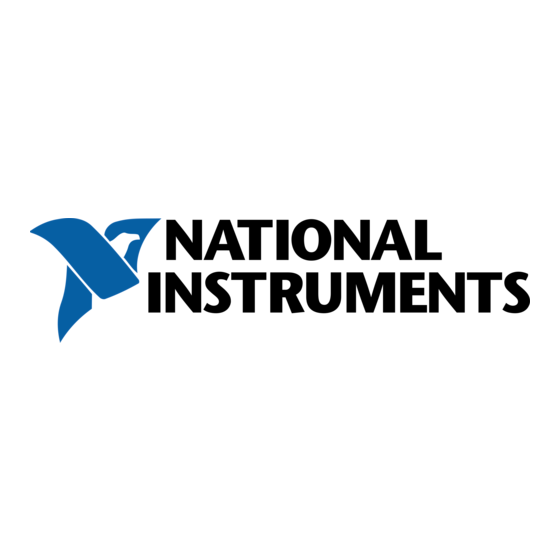

National Instruments SCB-100 Installation Manual
100-pin shielded desktop connector block
Hide thumbs
Also See for SCB-100:
- Installation manual (9 pages) ,
- Installation manual (16 pages) ,
- Installation manual (15 pages)
Table of Contents
Advertisement
INSTALLATION GUIDE
SCB-100
100-Pin Shielded Desktop Connector Block
This guide describes how to connect and use the NI SCB-100 with 100-pin data acquisition (DAQ)
devices. The SCB-100 is a shielded desktop accessory with 100 screw terminals, a cold-junction
compensation temperature sensor for use with thermocouples, and a strain-relief bar for securing signal
wires or cables. The SCB-100 connects to E Series MIO devices (NI 6025E, NI 6031E, NI 6033E,
and NI 6071E), DIO devices (PCI-DIO-96, NI 6508, NI 6509, NI 6511, NI 6512, NI 6513, NI 6514,
NI 6515, NI 6527, and NI 6528), TIO Series devices (NI 6624), or other products with a 100-pin
0.050 series shielded D-type I/O connector.
Note
To use the SCB-100 with a DIO or TIO Series device, you must change the default switch
setting. Refer to the
Figure 1 shows the SCB-100 connector block.
1
Quick Reference Label
2
Top Cover
3
100-Pin Connector Screw
Contents
What You Need to Get Started ............................................................................................................ 2
Attaching the Quick Reference Label.................................................................................................. 2
Getting Started with the SCB-100 ....................................................................................................... 2
Using the SCB-100 with DIO/TIO Devices ........................................................................................ 4
Using the SCB-100 with MIO Devices ............................................................................................... 5
Removing the Board ............................................................................................................................ 8
Soldering, Desoldering, and Cutting Via Traces on the SCB-100 Board............................................ 9
Specifications....................................................................................................................................... 9
Where to Go for Support ..................................................................................................................... 10
Using the SCB-100 with DIO/TIO Devices
9
8
7
4
Grounding Screw
5
100-Pin I/O Connector
6
Base
Figure 1. SCB-100 Connector Block
section for more information.
1
2
3
4
5
6
7
Strain-Relief Hardware
8
Strain-Relief Screws
9
SCB-100 Board Assembly
Advertisement
Table of Contents

Summary of Contents for National Instruments SCB-100
-
Page 1: Table Of Contents
The SCB-100 connects to E Series MIO devices (NI 6025E, NI 6031E, NI 6033E, and NI 6071E), DIO devices (PCI-DIO-96, NI 6508, NI 6509, NI 6511, NI 6512, NI 6513, NI 6514, NI 6515, NI 6527, and NI 6528), TIO Series devices (NI 6624), or other products with a 100-pin 0.050 series shielded D-type I/O connector. -
Page 2: What You Need To Get Started
Resistors and capacitors specific to your application (optional) Attaching the Quick Reference Label A quick reference label is included in the SCB-100 100-pin shielded connector block kit to show switch configurations and define screw terminal pinouts for E Series devices. Place the label on the inside of the top cover, as shown in Figure 1. - Page 3 Switches S1, S2, and S3 Figure 2. SCB-100 Board Parts Locator Diagram To get started with the SCB-100, complete the following steps while referring to Figures 1 and 2. Disconnect the 100-pin cable from the SCB-100, if connected. Remove the grounding screws on either side of the top cover with a Phillips #1 screwdriver.
-
Page 4: Using The Scb-100 With Dio/Tio Devices
Close the top cover. Reinsert the grounding screws to ensure proper shielding. 10. Connect the SCB-100 to the 100-pin connector. Using the SCB-100 with DIO/TIO Devices DIO devices, TIO Series devices, and DAQ devices without analog input functionality must use the DIO/passthrough mode. -
Page 5: Using The Scb-100 With Mio Devices
Using the SCB-100 with MIO Devices You can take measurements with the SCB-100 and MIO DAQ devices, such as E Series, in a number of ways. The SCB-100 has a temperature sensor for cold-junction compensation to accommodate thermocouples. Switches S4, S5, and S6 configure the temperature sensor for different analog input settings. - Page 6 Figure 4. MIO Device Modes Switch Settings Temperature Sensor Output and Accuracy The SCB-100 temperature sensor outputs 10 mV/°C and has an accuracy of ±0.5 °C. You also can determine the temperature using the following formulas: = 100 × V + 273.15...
- Page 7 If the MIO DAQ device is configured for differential inputs, ground-referenced signal sources connected to the SCB-100 board do not require special components added to the SCB-100 board. For detailed information on connections to ground-referenced signal sources and differential inputs, refer to the E Series User Manual.
-
Page 8: Removing The Board
For best results, use a well-calibrated MIO DAQ device so that offsets can be ignored. Eliminate offset error by grounding one channel on the SCB-100 board and measuring the voltage. This value, the offset of the MIO DAQ device, then can be subtracted by software from all other readings. -
Page 9: Soldering, Desoldering, And Cutting Via Traces On The Scb-100 Board
Use a low-wattage soldering iron (20 to 30 W) when soldering to the board. To desolder on the SCB-100, vacuum-type tools work best. Use care when desoldering to avoid damaging component pads. -
Page 10: Where To Go For Support
National Instruments corporate headquarters is located at 11500 North Mopac Expressway, Austin, Texas, 78759-3504. National Instruments also has offices located around the world to help address your support needs. For telephone support in the United States, create your service request at ni.com/... - Page 11 Instruments trademarks. Other product and company names mentioned herein are trademarks or trade names of their respective companies. For patents covering National Instruments products, refer to the appropriate location: Help»Patents in your software, the patents.txt file on your CD, or ni.com/patents.







Need help?
Do you have a question about the SCB-100 and is the answer not in the manual?
Questions and answers